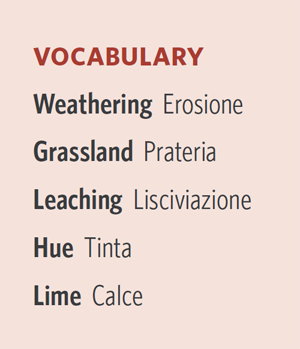A look at the chemistry of soil

CLIL - SCIENCE IN ENGLISH
Il pH dei suoli è un elemento molto importante per la loro fertilità. Ed è anche l'argomento del materiale CLIL di questo mese, insieme ad altri aspetti di chimica dei suoli, come i fattori che ne determinano il colore. L'articolo è accompagnato dalla traduzione in italiano e da una scheda didattica per lavorare, in classe o a casa, con l'inglese scientifico.

Soil constitutes the thin outer layer that covers the land surface of our planet. It forms over time due to the effects of climate, living organisms, topography and parent material (bedrock).
Soil is a complex substance composed of a mixture of organic and inorganic matter, and water- and air-filled gaps. Mineral particles are formed as a consequence of rock weathering, while organic matter comprises both living organisms and the remains of dead organisms. Soil provides all the important nutrients required by a plant.
Soil is of great importance for human life; it plays a crucial role in food availability, climate change adaptation and mitigation, and it provides essential ecosystem services to mankind (i.e. it provides support for plants by retaining and supplying nutrients; it holds and releases water, providing flood control and water purification benefits).
Soil colour depends on a variety of factors; many soil types display a brown colour due to the presence of iron oxides and organic matter. Red or yellow coloured soils, typical in the Tropics, may arise due to the presence of iron or aluminium oxides, respectively. Black soils are commonly associated with temperate grasslands, where the soil contains greater quantities of humus, the organic matter that gives rise to the black colouration. In coniferous forests, soils are often grey due to heavy leaching of iron. Soil may have greenish and grey-blue hues when high water tables cause the reduction of iron. Poorly drained soils may also exhibit blue, grey and green colours. Other materials that can affect soil colour include: calcium carbonate (white), manganese oxides (black), and carbon compounds (black).
Correct soil pH is essential for healthy plant growth, as it affects the type and amount of watersoluble nutrients and hence, determines their absorption by plants.
pH measurements range from 0 to 14, with values of 6.5 to 7.5 considered as ‘neutral’. Soils with a pH less than 6.5 are acidic, and soils with a pH less than 5.5 are considered strongly acidic. Highly acidic soils can have pHs as low as 3, whereas highly alkaline soils can reach a pH of 10. Most soils have pH values between 3.5 and 10, however plant growth is optimal in slightly acidic soils. Most mineral nutrients are readily absorbed when soil pH is near neutral, however some may be more readily absorbed in either acidic or alkaline conditions.
Some fertilisers can alter soil pH that can, in turn, either increase or decrease the availability of certain nutrients to plants. The pH of an alkaline soil can be reduced by the addition of crushed sulfur and ammonium-based nitrogen fertilisers. Conversely, acidic soils can be made less acidic (increasing the pH of the soil) by the addition of lime or dolomite.


